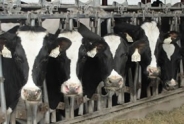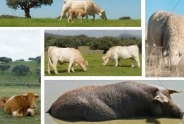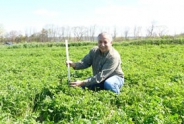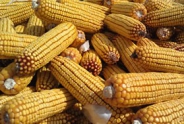First Cutting Updates - Week of May 29, 2018
Betsy Hicks, Area Dairy Specialist
South Central New York Dairy & Field Crops
An overall assessment of first cutting progress from fields we measured:
Most fields we measure have been harvested or are in the process of being cut. Early samples we've gotten back have shown that grass cut on recommendations looks really nice. One all grass sampled showed Adj Prot 22.0%, NDF 53.2 and NDFD 30h at 76. Early grass varieties are well headed by now, but later maturing grasses are just to head stage. If you have alfalfa fields standing alongside grass fields, it may be a good idea to harvest the grass for heifer or dry cow haylage, and focus on getting your alfalfa crop for lactating quality. Most alfalfa fields still standing are showing signs of early bud. A sample we've gotten back on a mostly alfalfa field cut on recommendations showed Adj Prot 22.6%, NDF of 48 and NDFD at 66, with the NDF and NDFD numbers a bit surprising. We'd like to see more samples of both grass and alfalfa and mixed if you'd like to share with Janice or Betsy. Also, please consider responding to our brief survey of how you use the reports to give your assessment of how we are doing in regards to timing of first crop. You can find the survey here: https://cornell.qualtrics.com/jfe/form/SV_6yxqOhaPo7YE22h. You can also reply to Betsy with any comments you may have on the use of the report or how we can improve. Your comments and feedback help us to be able to continue to provide this information every year!
Alfalfa height has been proven to be a reliable indicator of NDF values in the field for alfalfa, alfalfa/grass mixed and all grass stands. Results will be compiled and posted/sent out on a weekly basis. To receive weekly email/text updates, please contact us at 607.391.2673 with your preference of email or cell phone number and mobile carrier. The email will contain the report as an attachment, the text update will contain a link to view the report on our website. To be removed from this list, email Betsy at bjh246@cornell.edu.
The numbers that are indicators for using alfalfa heights for NDF content are as follows:
- 100% grass stands should be cut when nearby alfalfa is 14 inches tall, to achieve 50% NDF
- 50/50 mixed alfalfa/grass stands should be cut when nearby alfalfa is 22 inches tall, to achieve 44% NDF
- 100% alfalfa stands should be cut when alfalfa is 28 inches tall, to achieve 40% NDF
Predicted days to cut are based on daily NDF increases for grasses of 1.0% point, 50/50 mixed alfalfa/grass stands of 0.8% points, and alfalfa of 0.5% points.
Predictions are adjusted for the coming week's weather.
- Typically NDF increases about 0.8 to 1.2 per day for grasses, with cooler weather being the lower end of the range and warmer weather being the higher end.
- For alfalfa, NDF increases about 0.4 to 0.7 per day, also dependent upon warm/cool weather.
The weekly email will have a table of the locations around the region where we have measured the alfalfa height, as well as the elevation, and target date for harvest. Even if your fields aren't measured, you can use the location and elevation as a guide to conditions that may be similar to your own.
Alfalfa height reporting sheet 5.29.18 (pdf; 254KB)
- alfalfa heights for Broome, Cortland, Chemung, Onondaga, Tioga and Tompkins Counties
Upcoming Events
Dairy Systems & Technology Showcase - Cortland County Tours
November 5, 2025 : Fall Farm Tour - Cortland County
- Guided facility walk through of new dairy systems and technologies on farms across NYS led by CCE Dairy Specialists, PRO-DAIRY, and other industry experts.
- Intended audience: Dairy farmers and industry partner
Spanish Dairy Webinar Series
September 3, 2025
September 10, 2025
September 17, 2025
September 24, 2025
October 1, 2025
October 8, 2025
October 15, 2025
October 22, 2025
October 29, 2025
November 5, 2025
Daniela Gonzalez Carranza is happy to announce a collaboration with the University of Wisconsin-Madison for a dairy webinar series only in Spanish.
Beef Quality Assurance - Training Day
November 15, 2025 : Beef Quality Assurance - Training Day
Announcements
USDA Contract Freezes and Terminations: Legal Action Steps for Farmers
For Farmers with Signed EQIP and CSP ContractsThis resource is written for farmers and ranchers nationwide who have a signed contract with USDA NRCS under the EQIP or CSP program for environmental improvements but have concerns that their contract is frozen, under review, or terminated, and who are uncertain of their rights to receive reimbursement as well as their ongoing obligations under the signed contract.
Version: 1.0
Issue date: Feb 28, 2025
A downloadable factsheet is available at our BUSINESS tab on the top of our webpage.
Additional Information: www.farmcommons.org
USDA Contract Freezes: Filing an NAD Appeal or Demand Letter
This resource is written for farmers and ranchers nationwide who have a signed contract with USDA NRCS under the EQIP or CSP program for environmental improvements and want more information on the mechanics of filing a National Appeals Division (NAD) appeal. This resource includes sample letters.
USDA NAD Appeal https://www.usda.gov/about-usda/general-information/staff-offices/office-hearings-and-appeals/national-appeals-division/nad-appeals
Farm Participants Needed for Bale Grazing Grant!
Information on the Project:- Approximately 10 acres total needed to bale graze two different bale densities
- "Core" farms will graze two winters, "Demo" farms will graze one winter.
- Payments for both "Core" farms and "Demo" farms
- Baseline soil sampling by bale grazing team
- Forage measurements in early season by bale grazing team
- Late season clipping if residual not trampled down by farm
Cornell Cow Convos - New Podcast
On-going podcast, New episodes released on the last Thursday of the month.Guest speakers, CCE Dairy Specialists.
Housed on Soundcloud Channel is CCE Dairy Educators
- Preventative healthcare for cows
- The trend of beef on dairy
- What to look forward to in the new year for dairy
- Socially grouping or pair-housing calves
2018 Drug Residue Prevention Manual
For more than 30 years, the U.S. dairy industry has focused educational efforts on the judicious use of antibiotics through the annual publication of a Best Practices Manual. The 2018 edition of the National Dairy FARM Program: Farmers Assuring Responsible Management? Milk and Dairy Beef Drug Residue Prevention Manual is the primary educational tool for dairy farm managers throughout the country on the judicious and responsible use of antibiotics, including avoidance of drug residues in milk and meat.The manual is a quick resource to review those antibiotics approved for dairy animals and can also be used as an educational tool and resource for farm managers as they develop on-farm best management practices necessary to avoid milk and meat residues. Visit the Manual and Form Library to download copies of this important tool!
Follow us on Facebook
The team updates our facebook page frequently - follow us to be updated on our events, see some fun videos and get local area updates!facebook.com/SCNYDairyandFieldCropsTeam
NYSERDA Agriculture Energy Audit Program
NYSERDA offers energy audits to help eligible farms and on-farm producers identify ways to save energy and money on utility bills. Reports include recommendations for energy efficiency measures.For more information and the NYSERDA Agriculture Energy Audit Program Application click here





